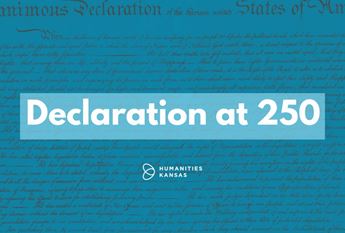

Big Idea: Turning Land Acknowledgements into Action…In a Good Way
April 13, 2022
By Dr. Alex Red Corn (Osage Nation), EdD, executive director of the Kansas Association of Native American Education, an assistant professor of educational leadership, and coordinator for Indigenous partnerships in the College of Education at Kansas State University.
As institutions in Kansas explore ways to be more responsive to diversity, land acknowledgments are becoming increasingly trendy. Because the establishment of the state of Kansas is inherently connected to forced migrations of Indigenous nations, I strongly believe the act of creating land acknowledgments is a good thing—but only as long as it is paired with action steps taken to improve education for, about, and with Native peoples. In other words, this work must be approached as many Natives might say, “in a good way.”
Indigenous peoples over the years have grown used to being visible in the pictures found on institutional diversity fliers. There is high demand for what I call “drum and feather” exhibitions in gymnasiums during Native American Heritage Month or cultural fairs. Creating these moments for American Indian people to express who they are is a great way to create culturally responsive learning moments for the benefit of all. Again, these are good things. However, creating culturally responsive environments must go deeper, and educators and organizational leaders developing land acknowledgments should consider the experiences that occur every day in schools, libraries, and historical museums. This is where the true hard work lies when creating a land acknowledgement, and it centers around an essential question: How do we improve education in our communities for, about, and with American Indian people? Furthermore, how do we do that in a good way?
So for those considering the development of a land acknowledgement, I applaud you, but here I offer some thoughts about areas that could generate meaningful action.
My research is in education, which I will use as an example, but these core issues are still relevant to learning environments found outside of our schools. When we create educational environments for American Indian students—young and old—we must ask ourselves if they are given the opportunity to learn about content that is relevant to their lives. Research led by Dr. Sarah Shear and her peers have shown us that most social studies standards across the country about American Indians are situated in a pre-1900 context, and that there are many states in the country that do not have any standards that prompt students to learn about the sovereignty of Native nations. Furthermore, the textbooks and media available to teachers fall into these same traps. In other words, our curricula, as well as most teaching materials, dictate that students only learn about Native peoples as stuck-in-the-past stereotypes. Additionally, while they learn about federal, state, and local governments, students do not learn about tribal governments. This is true even with four federally recognized Native nations in Kansas, and with many more Native nations in neighboring Oklahoma and Nebraska. So how can we expect all our students—Natives included—to leave our schools ready to interact with modern American Indians and nations if they did not learn about them in relevant ways?
When writing a land acknowledgement, it should be paired with critical action steps that dive into these questions, and those action steps should be approached in a good way. They should seek to ensure that community learning environments for and about American Indians are relevant to the modern lived experiences and ongoing existence as ever-evolving peoples, communities, and nations. This is good for all of us as we continue to live in and engage with the diversity of this world and confront the ethnic and racial entanglements we all inherited in this country.
When working to create these more responsive and relevant cultural experiences, it is also essential to consider what is possible when you tackle these issues in partnership with Native peoples, communities, and nations. American Indians are found in almost every county in Kansas, and these friends and neighbors are connected to Native nations in multiple states that have an inherent sovereign right to be involved in the education of and about their people. Historic land dispossession and relocation programs created a situation where over 90% of Native children are in public schools—not tribal schools or federal Indian schools. These students and families live in our urban centers, as well as our rural communities. They are not relegated to reservations; they are walking amongst us and they do not all look like the stuck-in-the-past stereotypes we learned about in schools. Therefore, states and local districts and governments share educational and social responsibility with these Native nations to care for their citizens, even when they are not near a reservation.
Therefore, when writing a land acknowledgement, engaging with relevant Native nations and communities and building partnerships with those entities is one way to take a land acknowledgement to the next level and turn it into action. When doing so, keep in mind that all Native nations and communities are different, and some operate with limited resources, so what those partnerships look like will vary, and their ability to respond to requests coming from multiple institutions can be overwhelming at times. However, initiating engagement from a place of mutual understanding and respect is a logical starting point for building relationships in a good way.
As you think about land acknowledgements, here are some possible action items that could move the acknowledgement beyond words:
- Critically examine your museum or school’s educational materials and consider updating them to reflect a modern American Indian experience;
- Consider the possibility of incorporating Native languages and cultures into your work, with guidance from Native nations born from respectful partnership development;
- Commit resources and time to partnership-building with Native nations and communities—focus on building meaningful relationships, and not just a grant. Be considerate of the burden that you might unintentionally place on them, and do not always expect them to come to you and your institution. You will also need to go to them;
- Commit resources to program building and scholarships for Native students; and
- Explore ways to create professional pathways for Native’s in the educational and cultural sectors of our communities.
No land acknowledgement will be perfect, but if you choose to develop one make sure you are intentional that it is a starting point that should be tended to and grown for years to come. Inspired by ongoing work around this happening at the University of Kansas, our current land acknowledgement at Kansas State University is being updated right now for these very reasons—with a more intentional focus on process, action, and turning it into an educational and interactive tool for the community. In other words, we want it to become something much more impactful than just words posted on a website and recited before events. We want it to represent an ecosystem of meaningful relationships and strategic action to improve our communities. That is the hope, and that can only be accomplished if we approach this work…
in a good way.

ABOUT ALEX RED CORN
Dr. Alex Red Corn (Osage Nation), EdD, is executive director of the Kansas Association of Native American Education, an assistant professor of educational leadership, and coordinator for Indigenous partnerships in the College of Education at Kansas State University.
SPARK A CONVERSATION
-
WATCH K-State Indigenous students share the university’s land acknowledgment
- READ Haskell Indian Nation’s University professor Rhonda LeValdo wrote about the importance of land acknowledgments in KANSAS! Magazine
- Critics of land acknowledgments say they relegate Indigenous people to the past. Learn more about contemporary Native America in David Treuer’s The Heartbeat of Wounded Knee



